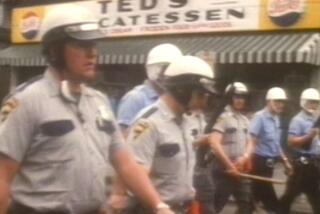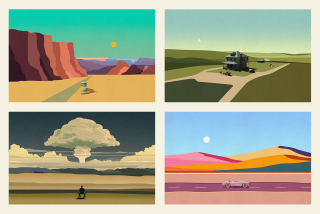TV REVIEW - ‘Ford’s America’ Honors King of the Western
- Share via
Orson Welles once said his three great influences were “John Ford, John Ford and John Ford.” Ford may not have been the greatest or the most influential of American film makers, as Marino Amoruso’s new documentary insists. Superlatives are always hard to deal with. Ford was one of that small handful who have left a large and indelible mark on the course of film history.
Today at 2 and 8 p.m., cable-TV’s American Movie Classics offers the first of what will be several showings of “John Ford’s America,” written and directed by Amoruso and hosted by Harry Carey Jr. Like his father, Harry Carey Sr., and his mother, Olive, Carey was a member of the Ford stock company, whose leading member was John Wayne, but which also included Henry Fonda, James Stewart (twice), Ward Bond, Ben Johnson, Jane Darwell and Mildred Natwick.
Ford, born in Ireland, captured American history--the mythic spirit if not the footnoted facts of it--better than anyone before or since (a superlative that will serve tolerably well).
There are wonderful clips from “Drums Along the Mohawk,” one of the very few memorable films about the Revolutionary War period, and from “My Darling Clementine” and some of the other great Ford Westerns.
From the archive footage, none measures the passage of time more ironically than a glimpse (with sound) of Ford and Henry Fonda visiting Century City, once the Fox backlot, at the start of the ‘70s, and trying to place where Fonda had taken a top-hatted walk in “Young Mr. Lincoln.” It looks to have been along what is now Avenue of the Stars. It had started to rain during the shot, Fonda recalled. “The tears of the multitudes, you called ‘em, Pappy,” Fonda says.
There are also shots, provided by Ford’s grandson and biographer Dan Ford, of Wayne and other Ford pals marlin-fishing off Mazatlan on Ford’s boat, “The Araner.” The commentaries, by James Stewart and Wayne himself, make much of Ford’s preference for action over words. “Action’s what we get paid for,” Ford himself says in a clip. Yet it’s instructive to see, even in the documentary’s brief extracts, what unforgettable words Ford found room for: none more eloquent than Fonda’s soliloquy at the end of “The Grapes of Wrath”: “Wherever there’s a fight so hungry people can eat, I’ll be there. . . .” Hard to watch it even now without a lump in the throat.
Ford also argued that he’d rather have good music than bad dialogue, and Amoruso’s documentary amply demonstrates how skilled Ford was in building music into the films. He made “Red River Valley” as expressively melancholy as a full-score requiem.
Gruff and private, Ford spoke little in public about his art or anything else. But his pals have had a lot to say about him, and his films say it all eloquently anyway. A prime reason for the decline of the Western is undoubtedly because Ford, who died in 1973, has not been around to make them.
“John Ford’s America” does him reverential honor.
More to Read
The complete guide to home viewing
Get Screen Gab for everything about the TV shows and streaming movies everyone’s talking about.
You may occasionally receive promotional content from the Los Angeles Times.






